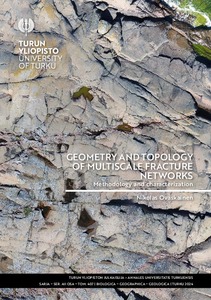Geometry and topology of multiscale fracture networks - Methodology and characterization
Ovaskainen, Nikolas (2024-05-03)
Geometry and topology of multiscale fracture networks - Methodology and characterization
Ovaskainen, Nikolas
(03.05.2024)
Turun yliopisto
Julkaisun pysyvä osoite on:
https://urn.fi/URN:ISBN:978-951-29-9691-9
https://urn.fi/URN:ISBN:978-951-29-9691-9
Tiivistelmä
The study of bedrock fracture networks is essential for applications such as modelling fluid flow, predicting radionuclide and geothermal heat transfer as well as overcoming bedrock engineering challenges since the fractures affect a number of physical characteristics of the bedrock. However, the multiscale nature of these fracture networks poses challenges in observation and analysis as fractures occur at all scales from centimeter-scale features on outcrops to kilometer-scale tectonic margins. To overcome this challenge, this doctoral thesis focuses on the geometry and topology of two-dimensional multiscale fracture networks and presents methods for their multiscale investigation – both existing, from the literature, but also novel methods developed under the course of this work. Scale-independent methods are introduced and employed, allowing for the direct comparison of data collected at different scales. Geometric fracture network properties encompass fracture lengths, orientations, and intensity i.e. the spatial distribution of fractures. Furthermore, the analysis of topological properties focuses on the connectivity and fracture relationships, offering valuable information about the flow potential within the fracture network and potential age relations between fractures, respectively.
This thesis comprises three articles that both address a specific research question in fracture studies while presenting novel methods for these purposes. Research issues include the identification of faults, their damage zones and fracturing that is kinematically unrelated, determination of the data requirements for accurate fracture network characterization and prediction of fracture properties, such as length, for scales of observation, where data collection is challenging. As a result of applying the presented methods, it was found how pre-existing faults affect later fracturing and how through subsampling of fracture trace data the accuracy of fracture data can be assessed. Furthermore, the thesis comprised fracture data collection in length ranges that had previously lacking data and provided estimations on predicting fracture lengths within crystalline rocks.
This thesis comprises three articles that both address a specific research question in fracture studies while presenting novel methods for these purposes. Research issues include the identification of faults, their damage zones and fracturing that is kinematically unrelated, determination of the data requirements for accurate fracture network characterization and prediction of fracture properties, such as length, for scales of observation, where data collection is challenging. As a result of applying the presented methods, it was found how pre-existing faults affect later fracturing and how through subsampling of fracture trace data the accuracy of fracture data can be assessed. Furthermore, the thesis comprised fracture data collection in length ranges that had previously lacking data and provided estimations on predicting fracture lengths within crystalline rocks.
Kokoelmat
- Väitöskirjat [2889]
